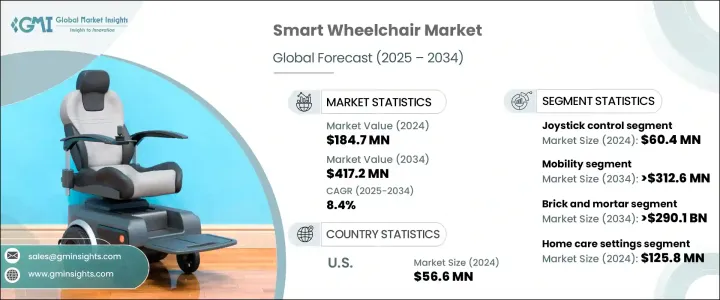
세계의 스마트 휠체어 시장은 2024년 1억 8,470만 달러로 평가되었고, 2034년에는 4억 1,720만 달러에 달할 것으로 예측되며, CAGR 8.4%로 성장할 전망입니다. 이러한 성장은 고령화 인구 증가, 장애율 상승, 가정 의료 모델의 확대, 장애 포용에 대한 정부 및 비영리 단체의 지원 증가에 기인합니다. 관절염, 신경근 장애, 골다공증과 같은 질환은 종종 노인의 이동을 어렵게 합니다. 그 결과, 스마트 휠체어와 같은 첨단 이동 솔루션에 대한 수요가 증가하고 있습니다. 이러한 기기는 원격 제어, 장애물 감지, 자동 내비게이션과 같은 기능을 제공하여 고령 사용자의 독립성과 이동성을 크게 향상시킵니다.

동시에, 후천적 및 선천적 장애를 가진 사람들의 수가 전 세계적으로 계속 증가하고 있습니다. 오늘날의 의료 시스템은 재활에 더 중점을 두고 있으며, 이로 인해 스마트 휠체어가 중요한 이동성 솔루션으로 채택되는 것이 촉진되었습니다. 이 휠체어는 이동이 불편한 사람들의 자유를 향상시키고 일상 생활에 통합되며 전반적인 삶의 질을 높이는 데 도움이 됩니다. 스마트 휠체어는 지능형 기술을 통합하여 사용자가 주변을 더 안전하고 효과적으로 이동할 수 있도록 지원합니다. 이러한 시스템은 물리적 장벽을 제거하고 자율성을 향상시켜 이동 보조 기기에 의존하는 사람들의 생활 수준을 향상시킵니다.
| 시장 범위 | |
|---|---|
| 시작 연도 | 2024년 |
| 예측 연도 | 2025-2034년 |
| 시작 금액 | 1억 8,470만 달러 |
| 예측 금액 | 4억 1,720만 달러 |
| CAGR | 8.4% |
2024년에 조이스틱으로 제어되는 스마트 휠체어 부문은 6,040만 달러의 매출을 올렸습니다. 이들의 광범위한 인기는 비용 효율성과 직관적인 제어 방식에 기인하며, 상체 근력과 협응력이 있는 사용자에게 이상적입니다. 조이스틱 모델은 단순한 디자인과 짧은 학습 곡선으로 인해 임상 및 가정 간호 환경에서 널리 채택되고 있습니다. 이 기기들은 다양한 인체공학적 형태로 제공되며 반응 속도를 쉽게 조정할 수 있어 노인 및 어린이를 포함한 다양한 연령층에 적합합니다.
오프라인 유통 부문은 연평균 8.2%의 성장률을 보이며 2034년에는 매출이 2억 9,010만 달러에 달할 것으로 예상됩니다. 재활 센터 및 의료용품 판매점을 포함한 오프라인 매장은 개인 맞춤형 상담, 평가? 제품 체험을 제공합니다. 구매자는 전문가의 안내를 받고 구매 전에 편안함, 조정성 및 성능을 평가할 수 있습니다. 이 매장은 사후 서비스도 제공하며 의료 제공자와 보험사와 긴밀히 협력해 인증된 의료용 장비의 신뢰할 수 있는 공급원으로 기능합니다.
미국의 스마트 휠체어 시장은 2024년 5,660만 달러에 달했으며 2034년까지 연평균 성장률(CAGR)은 7.3%를 보일 것으로 예측됩니다.
세계의 스마트 휠체어 시장에서 활약하는 주요 기업은 LUCI, SCEWO, Airwheel, YAMAHA, QUANTUM, ottobock, WHILL, KARMA, permobil, INVACARE 등입니다. 경쟁이 치열한 미래에서 입지를 공고히 하기 위해 주요 제조업체들은 제품 혁신, 사용자 중심 디자인, 소프트웨어 통합 강화 등 전략적 이니셔티브를 활용하고 있습니다. 많은 업체들이 자사 제품을 차별화하기 위해 AI 기반 내비게이션 및 장애물 감지 같은 기술에 투자하고 있습니다. 소매점 확대와 병원 및 재활 센터와의 파트너십을 통해 기업들은 브랜드 신뢰도를 구축하고 소비자 신뢰를 높일 수 있습니다.
The Global Smart Wheelchair Market was valued at USD 184.7 million in 2024 and is estimated to grow at a CAGR of 8.4% to reach USD 417.2 million by 2034. The growth is attributed to a surge in the aging population, rising disability rates, expanding home healthcare models, and increasing support from governments and nonprofit organizations for disability inclusion. Conditions like arthritis, neuromuscular disorders, and osteoporosis often make movement difficult for elderly individuals. As a result, the demand for advanced mobility solutions such as smart wheelchairs is increasing. These devices offer features like remote control, obstacle detection, and automated navigation, significantly improving independence and mobility for aging users.

At the same time, the number of individuals living with disabilities-both acquired and congenital-continues to rise globally. Healthcare systems today are more focused on rehabilitation, which has driven the adoption of smart wheelchairs as a vital mobility solution. These chairs help in enhancing freedom, integration into daily life, and overall quality of living for people with mobility impairments. Smart wheelchairs integrate intelligent technology to help users navigate their surroundings more safely and effectively. These systems eliminate physical barriers and enhance autonomy, enabling a better standard of living for individuals relying on mobility aids.
| Market Scope | |
|---|---|
| Start Year | 2024 |
| Forecast Year | 2025-2034 |
| Start Value | $184.7 Million |
| Forecast Value | $417.2 Million |
| CAGR | 8.4% |
In 2024, the joystick-controlled smart wheelchairs segment generated USD 60.4 million. Their widespread popularity is fueled by their affordability and intuitive control, making them ideal for users with upper-body strength and coordination. Joystick models are commonly adopted in clinical and homecare environments due to their straightforward design and short learning curve. These devices are available in various ergonomic shapes and can be easily customized for responsiveness, making them suitable for different age groups, including seniors and children.
The brick-and-mortar distribution segment is set to grow at a CAGR of 8.2%, with revenue expected to reach USD 290.1 million by 2034. Physical stores, including rehabilitation centers and medical supply outlets, offer personalized consultations, assessments, and hands-on product trials. Buyers benefit from expert guidance and can evaluate comfort, adjustability, and performance before purchasing. These stores also offer after-sales service and work closely with healthcare providers and insurers, making them a reliable source for certified medical-grade equipment.
United States Smart Wheelchair Market reached USD 56.6 million in 2024 and is anticipated to grow at a CAGR of 7.3% through 2034. The US continues to lead the market, supported by a well-developed healthcare infrastructure and robust innovation in medical mobility devices. The high prevalence of chronic conditions like spinal cord injuries and arthritis, combined with a growing elderly population, contributes to the increasing demand for smart wheelchairs across the country.
Key companies active in the Global Smart Wheelchair Market include: LUCI, SCEWO, Airwheel, YAMAHA, QUANTUM, ottobock, WHILL, KARMA, permobil, and INVACARE. To solidify their position in the competitive landscape, leading manufacturers are leveraging strategic initiatives such as product innovation, user-centric design, and enhanced software integration. Many are investing in technologies like AI-based navigation and obstacle detection to differentiate their offerings. Expanding their retail presence and forming partnerships with hospitals and rehabilitation centers are helping companies build brand credibility and improve consumer trust.